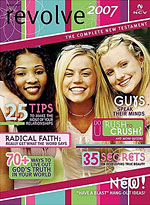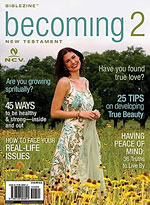Archive for the ‘The Bible’ Category
Friday, September 24th, 2010 by JEL
Laura Hobgood-Oster has a new book coming out on October 1 called “The Friends We Keep: Unleashing Christianity’s Compassion for Animals.” She is a professor of Religion and Environmental Studies (quite a combination!) at Southwestern University in Texas and makes a scripture-based argument that that “God created all living things to exist in relationship to humankind. We have a moral responsibility of kindness and concern to non-human beings. In turn, animals sustain our existence, both physically as food and emotionally as companions. Turn a blind eye to their plight and we underwrite our own undoing.”
 As the owner of a new puppy, I am practicing (with great effort at times) the compassion needed to sustain a healthy companion relationship with a pet. But pets are (relatively) easy. What about the chickens with their beaks sawed off to avoid pecking each other in the packed confines of their cages, pigs with teeth removed to save the iron bars of their pens, calves prevented from having iron to keep their veal meat a more cosmetically pleasing white?
As the owner of a new puppy, I am practicing (with great effort at times) the compassion needed to sustain a healthy companion relationship with a pet. But pets are (relatively) easy. What about the chickens with their beaks sawed off to avoid pecking each other in the packed confines of their cages, pigs with teeth removed to save the iron bars of their pens, calves prevented from having iron to keep their veal meat a more cosmetically pleasing white?
If I’m God and I created all these creatures, I sure wouldn’t be pleased with how we’re treating them.
Tags: animal welfare, Christianity, Laura Hobgood-Oster
Posted in In The News, The Bible | No Comments »
Monday, September 20th, 2010 by JEL
David Gushee, a professor of Christian ethics at Mercer University, wrote a very compelling piece last week. The Terry Jones Koran-burning saga was the impetus, but he touches on a number of topics that hit home:
“I remember the first time it became crystal clear to me that there is no such thing as Christianity, but only competing Christianities. It was when I was working on my doctoral dissertation on Christians who rescued Jews during the Holocaust. During that time I attended a most remarkable conference in New York on hidden children of the Holocaust. This gathering brought together the now-grown adults who had hidden from the Nazis to survive. Some of these children were saved by Christian families.
The most memorable speaker for me was a hidden child, and now a sociologist, named Nechama Tec. A Polish Jew, she survived the war hiding with Christians. She was asked after her address whether it was Christianity that motivated her rescuers. Her unforgettable response went like this: ‘It wasn’t just any kind of Christianity that would motivate a rescuer. Only a certain kind of Christianity would lead someone to risk their lives for us.’
A certain kind of Christianity — the phrase stayed with me. It is enormously helpful. From hard experience, young Nechama Tec learned the difference between versions of Christianity that teach hatred of the religious/ethnic other and versions that teach sacrificial and inclusive love. Her very survival depended on being able to tell the difference between these competing Christianities and the people who embodied them.”
Read the whole thing. His closing paragraph about competing versions of Islam seems right on to me.
Tags: Christianity, competing Christianities, David Gushee, Terry Jones
Posted in In The News, The Bible | No Comments »
Wednesday, July 7th, 2010 by JEL
If you want to set off fireworks at your next social gathering, bring up “unions” as a topic of conversation. Chances are you’ll get passionate views on both sides. But where do God and religion stand?
Catholic Scholars for Worker Justice recently published a document saying that:
“Catholic social doctrine is ‘forthright and unambiguous’ in regard to unions. ‘It states boldly that they are essential to the universal common good.’ […] Opposing unions—that is, opposing the workers’ natural right of free assembly and right to decent wages and benefits—harms not only the workers directly involved. It also hurts society at large by lessening overall income and social solidarity and, thus, diminishing the universal common good.”
The impetus for the work was the anti-union activities of certain Catholic dioceses and Catholic organizations that were obviously not following church doctrine.
Tags: Catholic Church, Catholic Scholars for Worker Justice, free assembly, Unions
Posted in In The News, The Bible | No Comments »
Monday, April 12th, 2010 by JEL
The Rev. Howard Bess, in this article, talks about forgetting about retribution and revenge. And argues that what Jesus preached at the end of the Sermon on the Mount was going completely against the grain of what anyone—including God—practiced or believed at the time (or now). Here’s what Jesus said:
“You have heard that it was said, ‘An eye for an eye, and a tooth for a tooth.’ But I tell you, don’t resist him who is evil; but whoever strikes you on your right cheek, turn to him the other also.” — Matthew 5:38-39
Jesus believed in forgiveness, not in sin as a debt to be repaid. Bess titles his article, “How Christianity Lost Jesus” and feels that the western world in this century has embraced “an eye for an eye” in utter rejection of what Christ taught. How did it happen? Read the article and see his description of how Paul’s theology trumped Jesus’ teachings. Bess closes with:
“There is no evidence that the practice of ‘eye for an eye and a tooth for a tooth’ ever produced an honorable result, made people more whole with lives that are more satisfying, or produced a society that is good for all.”
Tags: Jesus, Paul, Rev. Howard Bess, Sermon on the Mount
Posted in Four Gospels, The Bible, Words of Christ | No Comments »
Thursday, April 1st, 2010 by PJM
Religion scholar Scott Korb has written a history book detailing everyday life 2,000 years ago. It is entitled ‘Life In Year One’: The World As Jesus Found It and he is careful to point out that, while the book describes people in Jesus’ time, it is not a book about Jesus. Korb was interviewed yesterday on NPR’s Talk of the Nation. You can find out more, listen to the interview and read an excerpt here.
I thought his response to a question about the accuracy of the written record was interesting:
…where we find discrepancies from one Gospel to another, that doesn’t really tell us anything about Jesus. It tells us about the people who were writing about Jesus.
Tags: Bible study, historical, Jesus, recent books
Posted in In The News, The Bible | No Comments »
Tuesday, February 16th, 2010 by JEL
I was perusing some best-seller lists for the past few years and became curious about the top-selling books of all time. Here’s what Wikipedia has for the top 14:
- The Bible
- Quotations from Chairman Mao (Little Red Book)
- The Koran
- Xinhua Dictionary
- Chairman Mao’s Poems
- Selected Articles of Mao Zedong
- A Tale of Two Cities (Charles Dickens)
- Scouting for Boys: A Handbook for Instruction in Good Citizenship
- The Lord of the Rings (J.R.R. Tolkien)
- Book of Mormon
- The Truth That Leads to Eternal Life (Jehovah’s Witnesses)
- On the Three Representations
- And Then There Were None (Agatha Christie)
- The Hobbit (J.R.R. Tolkien)
Quite the interesting list. I think Chairman Mao’s three entries greatly benefited from compulsory reading/ownership of over 1 billion people. Five are religious books; six if you throw in the Scouting book and its link to Christianity. And Agatha Christie?
Tags: Agatha Christie, best-sellers, Bible
Posted in Irreverant, The Bible | No Comments »
Thursday, January 21st, 2010 by JEL
Some critics are calling “The Book of Eli” a “Christian blockbuster.” In the movie, set in the aftermath of a nuclear apocalypse, Denzel Washington’s Eli has the last remaining copy of the King James Bible. The bad guy (Gary Oldman) wants the book as a means of controlling his ruthless band of marauders. Eli defends The Book (supposedly because he knows its power to bring good back to the world) by hacking, stabbing, and beheading—without remorse—anyone who gets in his way.
In this article, writer S.E. Cupp makes the excellent point that if Eli were portrayed as a Muslim defending the Koran with the same methods, Muslim-Americans would be outraged that the hero “acted more like a murderous jihadist than a humble servant of God.” And rightly so.
So why aren’t Christians similarly outraged? And why does Popmatters.com say, “Christians should be lining up to embrace the Hughes brothers’ brave vision.”? Seems like just another example of the message of Christianity being completely inverted by those trying to deliver it—and completely misunderstood by the recipients.
Tags: Christianity, Denzel Washington, Hollywood, King James Bible, The Book of Eli
Posted in In The News, The Bible | No Comments »
Friday, January 15th, 2010 by JEL
Scientists have long pegged the age of the Old Testament to the earliest known Hebrew writing. Until recently, that put the Hebrew Bible’s creation date somewhere in the 6th century B.C. Now, with the discovery of a 6-inch piece of ancient pottery, the O.T. just got 400 years older. That is, if you believe that the Bible’s authors started the instant they had a written language with which to work.
On the surface of the pottery, dated to the 10th century B.C., is written some text about how one should treat slaves, widows, and orphans. The content is apparently similar to Isaiah 1:17, Psalms 72:3, and Exodus 23:3.
Tags: Bible, Hebrew Bible, Old Testament
Posted in In The News, The Bible | No Comments »
Thursday, January 14th, 2010 by PJM
Quick. Take a look at the following magazine covers and figure out what they have in common.
Could you figure it out without reading the text? The answer is that they are all Bibles. They are, in fact, called Biblezines, and they each contain the complete text of the NCV New Testament. As the cover teasers suggest, there is also additional material interspersed with the biblical content that addresses burning issues like “How to Attract Godly Girls” and asks relevant questions like “Do U Rush To Crush?”
The first cover clearly tries to mimic a girl’s TeenBeat-like magazine, the next is similar in style to a boy’s extreme sports mag, the next looks like Redbook, and the last version which targets men is supposed to look like…I have no idea what that is supposed to look like. If you click on the covers, you can see that they receive mostly favorable praise along with the occasional one-star review from those who are offended by the entire concept.
Tags: Bible, Bible sales, christian book, Christianity, popular culture
Posted in The Bible | No Comments »
Wednesday, January 6th, 2010 by JEL
In spare moments, of which there are increasingly few, I like to research Bible design and see how What He Said compares and contrasts with other books from the past and present that try to ease a reader’s access to the words of Christ.
I recently came across this article which provides a nice overview of Bible design from the times of illuminated manuscripts to what the author, Matthew Griffin, calls “postmodern power plays.” He ends the piece with some interesting thoughts on timeless design:
“A truly Christian design of the Bible is one of balance. It is excellent, beautiful, and well organized. It does not elevate utilitarian concerns to the exclusion of beauty. Nor does it elevate embellishment to the exclusion of meaning. Its aim is toward God’s truth, not personal rhetoric. It is not afraid of legitimate graphical diversity. And It respects the text as a unified work of literature.”
I really like his definition and believe that What He Said (even though it’s not the entire Bible) meets his criteria. It is certainly graphically diverse, but does not disrupt the text as a unified whole.
Tags: Bible design, Gutenberg, illuminated manuscripts, Matthew Griffin
Posted in The Bible, What He Said - The Book, Words of Christ | 1 Comment »
 As the owner of a new puppy, I am practicing (with great effort at times) the compassion needed to sustain a healthy companion relationship with a pet. But pets are (relatively) easy. What about the chickens with their beaks sawed off to avoid pecking each other in the packed confines of their cages, pigs with teeth removed to save the iron bars of their pens, calves prevented from having iron to keep their veal meat a more cosmetically pleasing white?
As the owner of a new puppy, I am practicing (with great effort at times) the compassion needed to sustain a healthy companion relationship with a pet. But pets are (relatively) easy. What about the chickens with their beaks sawed off to avoid pecking each other in the packed confines of their cages, pigs with teeth removed to save the iron bars of their pens, calves prevented from having iron to keep their veal meat a more cosmetically pleasing white?




Join What He Said Online